
The Holocene is the current geological epoch. It began approximately 11,650 cal years before present, after the last glacial period, which concluded with the Holocene glacial retreat. The Holocene and the preceding Pleistocene together form the Quaternary period. The Holocene has been identified with the current warm period, known as MIS 1. It is considered by some to be an interglacial period within the Pleistocene Epoch, called the Flandrian interglacial.

The three-age system is the periodization of human pre-history into three time-periods: the Stone Age, the Bronze Age, and the Iron Age; although the concept may also refer to other tripartite divisions of historic time-periods. In history, archaeology and physical anthropology, the three-age system is a methodological concept adopted during the 19th century according to which artefacts and events of late prehistory and early history could be broadly ordered into a recognizable chronology. C. J. Thomsen (1788-1865), director of the Royal Museum of Nordic Antiquities in Copenhagen, initially developed this categorization in the period 1816 to 1825 as a result of classifying the museum's collections chronologically - there resulted broad sequences with artefacts made successively of stone, bronze, and iron.

The Kingdom of France was organised into provinces until the National Constituent Assembly adopted a more uniform division into departments (départements) and districts in late 1789. The provinces continued to exist administratively until 21 September 1791.

François-Étienne-Christophe Kellermann or de Kellermann, 1st Duke of Valmy was a French military commander, later the Général d'Armée, a Marshal of the Empire and a freemason. Marshal Kellermann served in varying roles throughout the entirety of two epochal conflicts, the French Revolutionary Wars and the Napoleonic Wars. Kellermann is one of the names inscribed under the Arc de Triomphe, on Column 3.

Édouard Lartet was a French geologist and paleontologist, and a pioneer of Paleolithic archaeology.

Jacques-Victor-Albert, 4th duc de Broglie was a French monarchist politician, diplomat and writer.
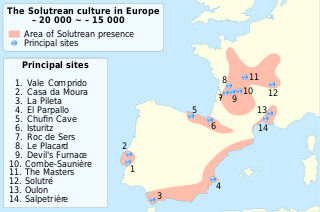
The Solutrean industry is a relatively advanced flint tool-making style of the Upper Paleolithic of the Final Gravettian, from around 22,000 to 17,000 BP. Solutrean sites have been found in modern-day France, Spain and Portugal.

The Magdalenian cultures are later cultures of the Upper Paleolithic and Mesolithic in western Europe. They date from around 17,000 to 12,000 years ago. It is named after the type site of La Madeleine, a rock shelter located in the Vézère valley, commune of Tursac, in France's Dordogne department.
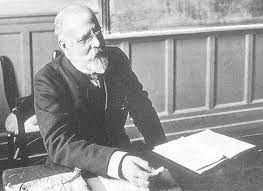
Charles Simon Clermont-Ganneau was a noted French Orientalist and archaeologist.
Censorinus was a Roman grammarian and miscellaneous writer from the 3rd century AD.

Louis Laurent Gabriel de Mortillet, French archaeologist and anthropologist, was born at Meylan, Isère.
The Albian is both an age of the geologic timescale and a stage in the stratigraphic column. It is the youngest or uppermost subdivision of the Early/Lower Cretaceous Epoch/Series. Its approximate time range is 113.0 ± 1.0 Ma to 100.5 ± 0.9 Ma. The Albian is preceded by the Aptian and followed by the Cenomanian.
Naulette, French: Caverne de la Naulette is a large cave located in Wallonia on the left bank of the Lesse, a tributary of the Meuse in the hills above Dinant, Belgium.
In the geologic timescale the Bathonian is an age and stage of the Middle Jurassic. It lasted from approximately 168.3 Ma to around 166.1 Ma. The Bathonian Age succeeds the Bajocian Age and precedes the Callovian Age.

Anthracotherium was a genus of extinct artiodactyl ungulate mammals, characterized by having 44 teeth, with five semi-crescentic cusps on the crowns of the upper molars. The genus ranged from the middle Eocene period until the early Miocene, having a distribution throughout Eurasia. Material subjectively assigned to Anthracotherium from Pakistan suggests the last species died out soon after the start of the Miocene.
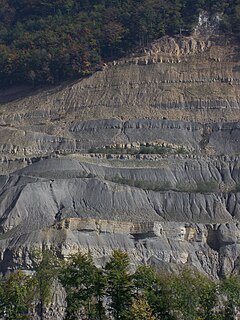
The Oxfordian is, in the ICS' geologic timescale, the earliest age of the Late Jurassic Epoch, or the lowest stage of the Upper Jurassic Series. It spans the time between 163.5 ± 4 Ma and 157.3 ± 4 Ma. The Oxfordian is preceded by the Callovian and is followed by the Kimmeridgian.
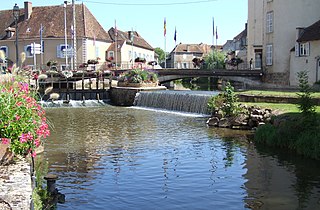
Charolles is a commune in the Saône-et-Loire department in the region of Bourgogne-Franche-Comté in eastern France. Since 2004 is Charolles part of the Charolais-Brionnais Country.
The Keuper is a lithostratigraphic unit in the subsurface of large parts of west and central Europe. The Keuper consists of dolomite, shales or claystones and evaporites that were deposited during the Middle and Late Triassic epochs. The Keuper lies on top of the Muschelkalk and under the predominantly Lower Jurassic Lias or other Early Jurassic strata.
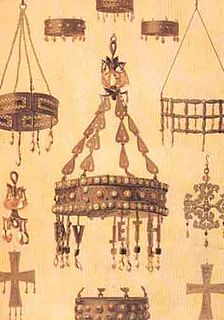
The Treasure of Guarrazar, Guadamur, Province of Toledo, Castile-La Mancha, Spain, is an archeological find composed of twenty-six votive crowns and gold crosses that had originally been offered to the Roman Catholic Church by the Kings of the Visigoths in the seventh century in Hispania, as a gesture of the orthodoxy of their faith and their submission to the ecclesiastical hierarchy. The most valuable of all is the votive crown of king Recceswinth with its blue sapphires from Sri Lanka and pendilia. Though the treasure is now divided and much has disappeared, it represents the best surviving group of Early Medieval Christian votive offerings.

Raymonden is a prehistoric cave near Chancelade in the French département Dordogne. The cave was inhabited during the Upper Paleolithic and contained, besides many artefacts, a human skeleton.














